Factors Affecting Child's Understanding of Abuse, Neglect and Child Protection Legislation in NSW
VerifiedAdded on 2023/06/17
|15
|4264
|134
AI Summary
This article discusses the factors affecting a child's understanding of abuse and neglect, indicators of neglect, sexual and physical abuse, child protection legislation in NSW, and mandatory reporting. It also covers the United Nations Convention on the Rights of the Child, trauma-informed care, ethical considerations, and the process of ethical decision-making.
Contribute Materials
Your contribution can guide someone’s learning journey. Share your
documents today.
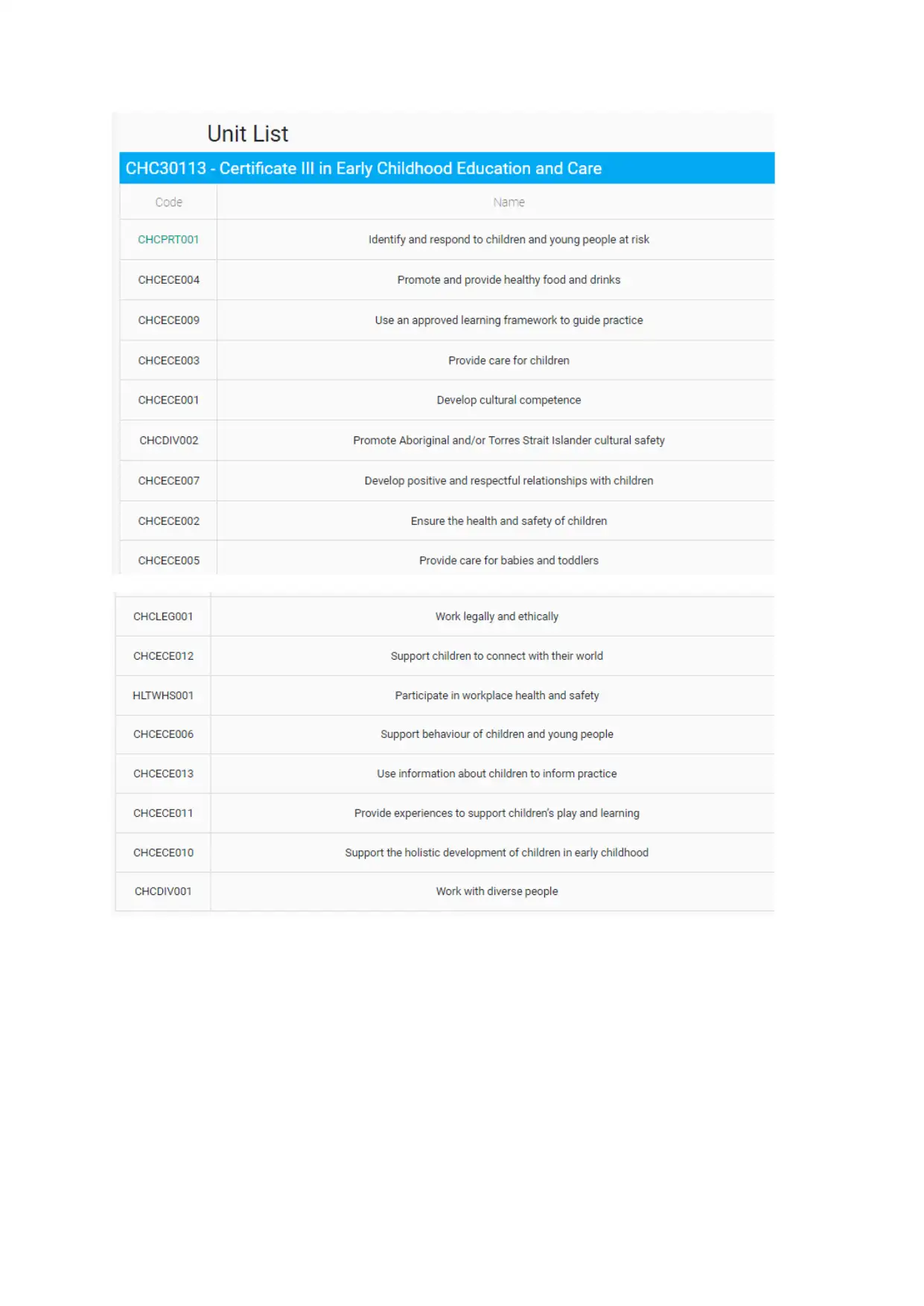
Secure Best Marks with AI Grader
Need help grading? Try our AI Grader for instant feedback on your assignments.
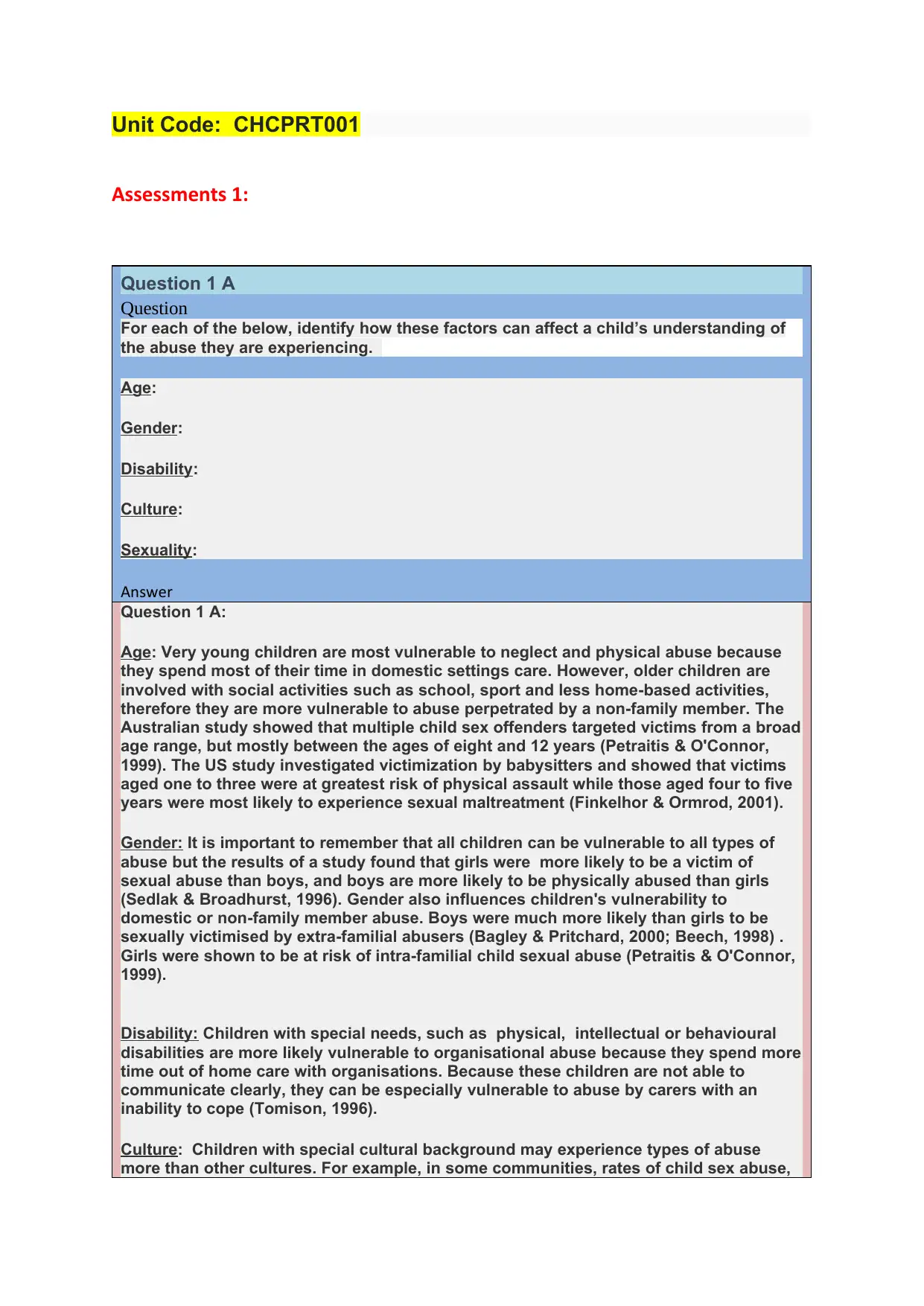
Unit Code: CHCPRT001
Assessments 1:
Question 1 A
Question
For each of the below, identify how these factors can affect a child’s understanding of
the abuse they are experiencing.
Age:
Gender:
Disability:
Culture:
Sexuality:
Answer
Question 1 A:
Age: Very young children are most vulnerable to neglect and physical abuse because
they spend most of their time in domestic settings care. However, older children are
involved with social activities such as school, sport and less home-based activities,
therefore they are more vulnerable to abuse perpetrated by a non-family member. The
Australian study showed that multiple child sex offenders targeted victims from a broad
age range, but mostly between the ages of eight and 12 years (Petraitis & O'Connor,
1999). The US study investigated victimization by babysitters and showed that victims
aged one to three were at greatest risk of physical assault while those aged four to five
years were most likely to experience sexual maltreatment (Finkelhor & Ormrod, 2001).
Gender: It is important to remember that all children can be vulnerable to all types of
abuse but the results of a study found that girls were more likely to be a victim of
sexual abuse than boys, and boys are more likely to be physically abused than girls
(Sedlak & Broadhurst, 1996). Gender also influences children's vulnerability to
domestic or non-family member abuse. Boys were much more likely than girls to be
sexually victimised by extra-familial abusers (Bagley & Pritchard, 2000; Beech, 1998) .
Girls were shown to be at risk of intra-familial child sexual abuse (Petraitis & O'Connor,
1999).
Disability: Children with special needs, such as physical, intellectual or behavioural
disabilities are more likely vulnerable to organisational abuse because they spend more
time out of home care with organisations. Because these children are not able to
communicate clearly, they can be especially vulnerable to abuse by carers with an
inability to cope (Tomison, 1996).
Culture: Children with special cultural background may experience types of abuse
more than other cultures. For example, in some communities, rates of child sex abuse,
Assessments 1:
Question 1 A
Question
For each of the below, identify how these factors can affect a child’s understanding of
the abuse they are experiencing.
Age:
Gender:
Disability:
Culture:
Sexuality:
Answer
Question 1 A:
Age: Very young children are most vulnerable to neglect and physical abuse because
they spend most of their time in domestic settings care. However, older children are
involved with social activities such as school, sport and less home-based activities,
therefore they are more vulnerable to abuse perpetrated by a non-family member. The
Australian study showed that multiple child sex offenders targeted victims from a broad
age range, but mostly between the ages of eight and 12 years (Petraitis & O'Connor,
1999). The US study investigated victimization by babysitters and showed that victims
aged one to three were at greatest risk of physical assault while those aged four to five
years were most likely to experience sexual maltreatment (Finkelhor & Ormrod, 2001).
Gender: It is important to remember that all children can be vulnerable to all types of
abuse but the results of a study found that girls were more likely to be a victim of
sexual abuse than boys, and boys are more likely to be physically abused than girls
(Sedlak & Broadhurst, 1996). Gender also influences children's vulnerability to
domestic or non-family member abuse. Boys were much more likely than girls to be
sexually victimised by extra-familial abusers (Bagley & Pritchard, 2000; Beech, 1998) .
Girls were shown to be at risk of intra-familial child sexual abuse (Petraitis & O'Connor,
1999).
Disability: Children with special needs, such as physical, intellectual or behavioural
disabilities are more likely vulnerable to organisational abuse because they spend more
time out of home care with organisations. Because these children are not able to
communicate clearly, they can be especially vulnerable to abuse by carers with an
inability to cope (Tomison, 1996).
Culture: Children with special cultural background may experience types of abuse
more than other cultures. For example, in some communities, rates of child sex abuse,
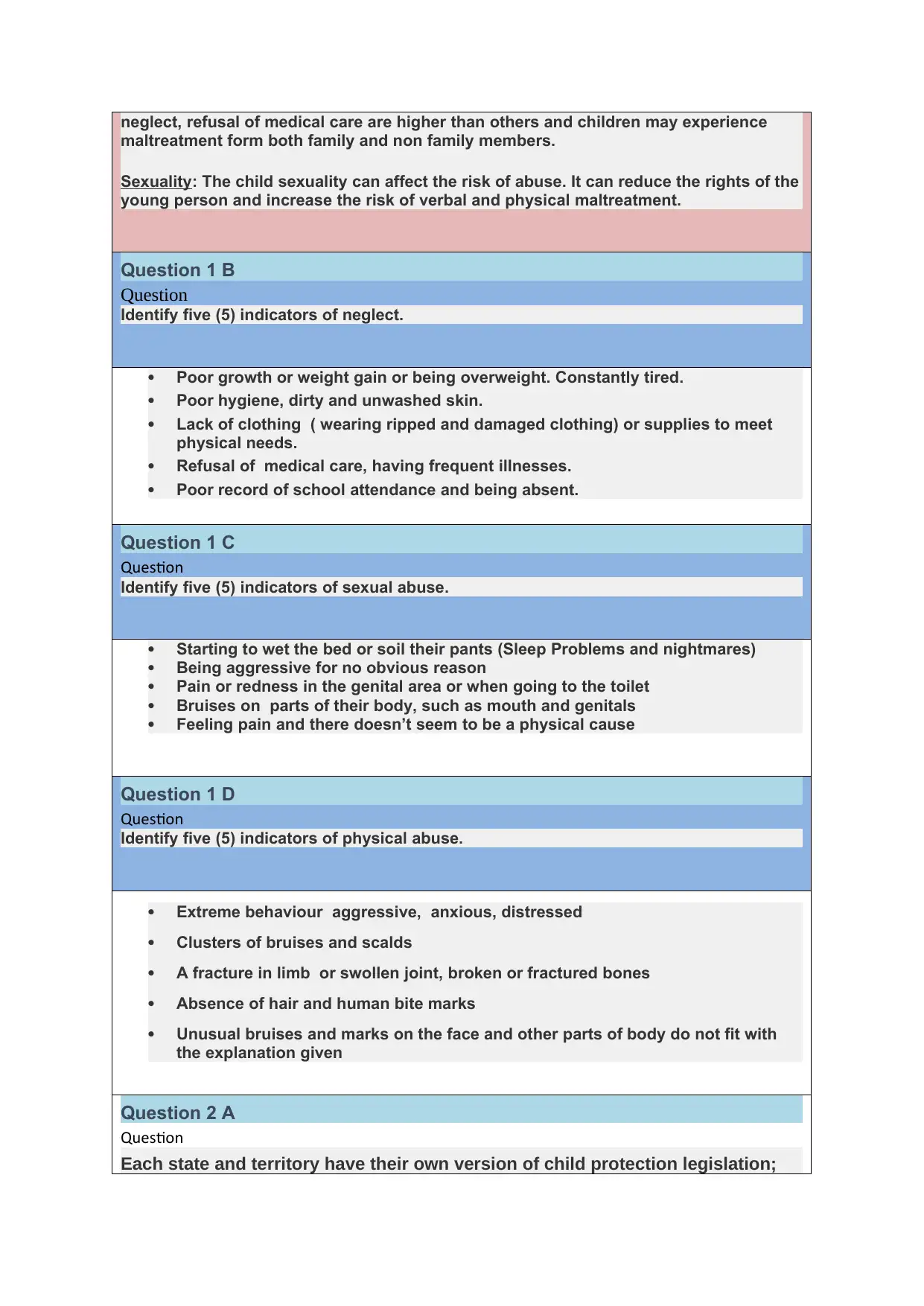
neglect, refusal of medical care are higher than others and children may experience
maltreatment form both family and non family members.
Sexuality: The child sexuality can affect the risk of abuse. It can reduce the rights of the
young person and increase the risk of verbal and physical maltreatment.
Question 1 B
Question
Identify five (5) indicators of neglect.
Poor growth or weight gain or being overweight. Constantly tired.
Poor hygiene, dirty and unwashed skin.
Lack of clothing ( wearing ripped and damaged clothing) or supplies to meet
physical needs.
Refusal of medical care, having frequent illnesses.
Poor record of school attendance and being absent.
Question 1 C
Question
Identify five (5) indicators of sexual abuse.
Starting to wet the bed or soil their pants (Sleep Problems and nightmares)
Being aggressive for no obvious reason
Pain or redness in the genital area or when going to the toilet
Bruises on parts of their body, such as mouth and genitals
Feeling pain and there doesn’t seem to be a physical cause
Question 1 D
Question
Identify five (5) indicators of physical abuse.
Extreme behaviour aggressive, anxious, distressed
Clusters of bruises and scalds
A fracture in limb or swollen joint, broken or fractured bones
Absence of hair and human bite marks
Unusual bruises and marks on the face and other parts of body do not fit with
the explanation given
Question 2 A
Question
Each state and territory have their own version of child protection legislation;
maltreatment form both family and non family members.
Sexuality: The child sexuality can affect the risk of abuse. It can reduce the rights of the
young person and increase the risk of verbal and physical maltreatment.
Question 1 B
Question
Identify five (5) indicators of neglect.
Poor growth or weight gain or being overweight. Constantly tired.
Poor hygiene, dirty and unwashed skin.
Lack of clothing ( wearing ripped and damaged clothing) or supplies to meet
physical needs.
Refusal of medical care, having frequent illnesses.
Poor record of school attendance and being absent.
Question 1 C
Question
Identify five (5) indicators of sexual abuse.
Starting to wet the bed or soil their pants (Sleep Problems and nightmares)
Being aggressive for no obvious reason
Pain or redness in the genital area or when going to the toilet
Bruises on parts of their body, such as mouth and genitals
Feeling pain and there doesn’t seem to be a physical cause
Question 1 D
Question
Identify five (5) indicators of physical abuse.
Extreme behaviour aggressive, anxious, distressed
Clusters of bruises and scalds
A fracture in limb or swollen joint, broken or fractured bones
Absence of hair and human bite marks
Unusual bruises and marks on the face and other parts of body do not fit with
the explanation given
Question 2 A
Question
Each state and territory have their own version of child protection legislation;
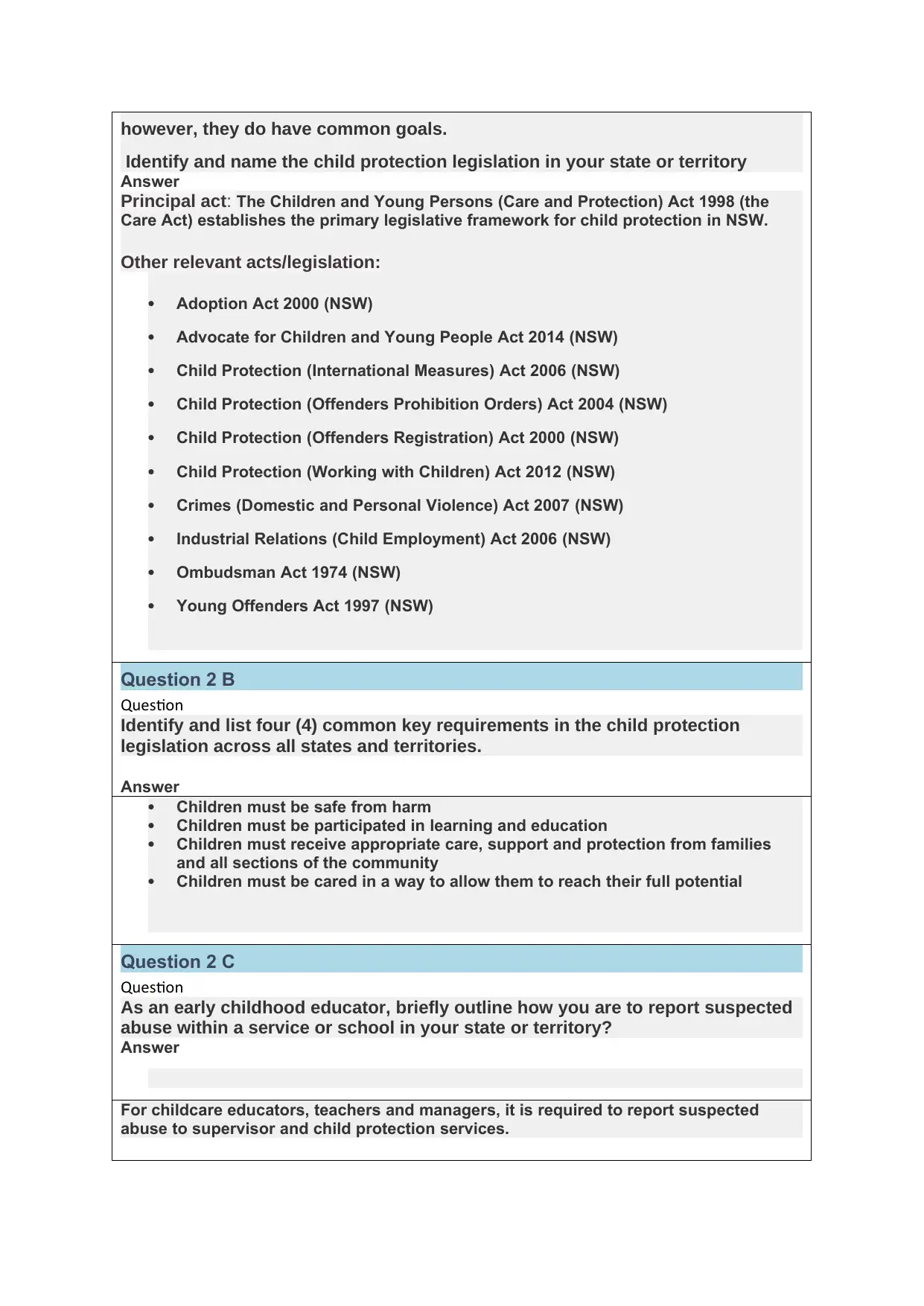
however, they do have common goals.
Identify and name the child protection legislation in your state or territory
Answer
Principal act: The Children and Young Persons (Care and Protection) Act 1998 (the
Care Act) establishes the primary legislative framework for child protection in NSW.
Other relevant acts/legislation:
Adoption Act 2000 (NSW)
Advocate for Children and Young People Act 2014 (NSW)
Child Protection (International Measures) Act 2006 (NSW)
Child Protection (Offenders Prohibition Orders) Act 2004 (NSW)
Child Protection (Offenders Registration) Act 2000 (NSW)
Child Protection (Working with Children) Act 2012 (NSW)
Crimes (Domestic and Personal Violence) Act 2007 (NSW)
Industrial Relations (Child Employment) Act 2006 (NSW)
Ombudsman Act 1974 (NSW)
Young Offenders Act 1997 (NSW)
Question 2 B
Question
Identify and list four (4) common key requirements in the child protection
legislation across all states and territories.
Answer
Children must be safe from harm
Children must be participated in learning and education
Children must receive appropriate care, support and protection from families
and all sections of the community
Children must be cared in a way to allow them to reach their full potential
Question 2 C
Question
As an early childhood educator, briefly outline how you are to report suspected
abuse within a service or school in your state or territory?
Answer
For childcare educators, teachers and managers, it is required to report suspected
abuse to supervisor and child protection services.
Identify and name the child protection legislation in your state or territory
Answer
Principal act: The Children and Young Persons (Care and Protection) Act 1998 (the
Care Act) establishes the primary legislative framework for child protection in NSW.
Other relevant acts/legislation:
Adoption Act 2000 (NSW)
Advocate for Children and Young People Act 2014 (NSW)
Child Protection (International Measures) Act 2006 (NSW)
Child Protection (Offenders Prohibition Orders) Act 2004 (NSW)
Child Protection (Offenders Registration) Act 2000 (NSW)
Child Protection (Working with Children) Act 2012 (NSW)
Crimes (Domestic and Personal Violence) Act 2007 (NSW)
Industrial Relations (Child Employment) Act 2006 (NSW)
Ombudsman Act 1974 (NSW)
Young Offenders Act 1997 (NSW)
Question 2 B
Question
Identify and list four (4) common key requirements in the child protection
legislation across all states and territories.
Answer
Children must be safe from harm
Children must be participated in learning and education
Children must receive appropriate care, support and protection from families
and all sections of the community
Children must be cared in a way to allow them to reach their full potential
Question 2 C
Question
As an early childhood educator, briefly outline how you are to report suspected
abuse within a service or school in your state or territory?
Answer
For childcare educators, teachers and managers, it is required to report suspected
abuse to supervisor and child protection services.
Secure Best Marks with AI Grader
Need help grading? Try our AI Grader for instant feedback on your assignments.
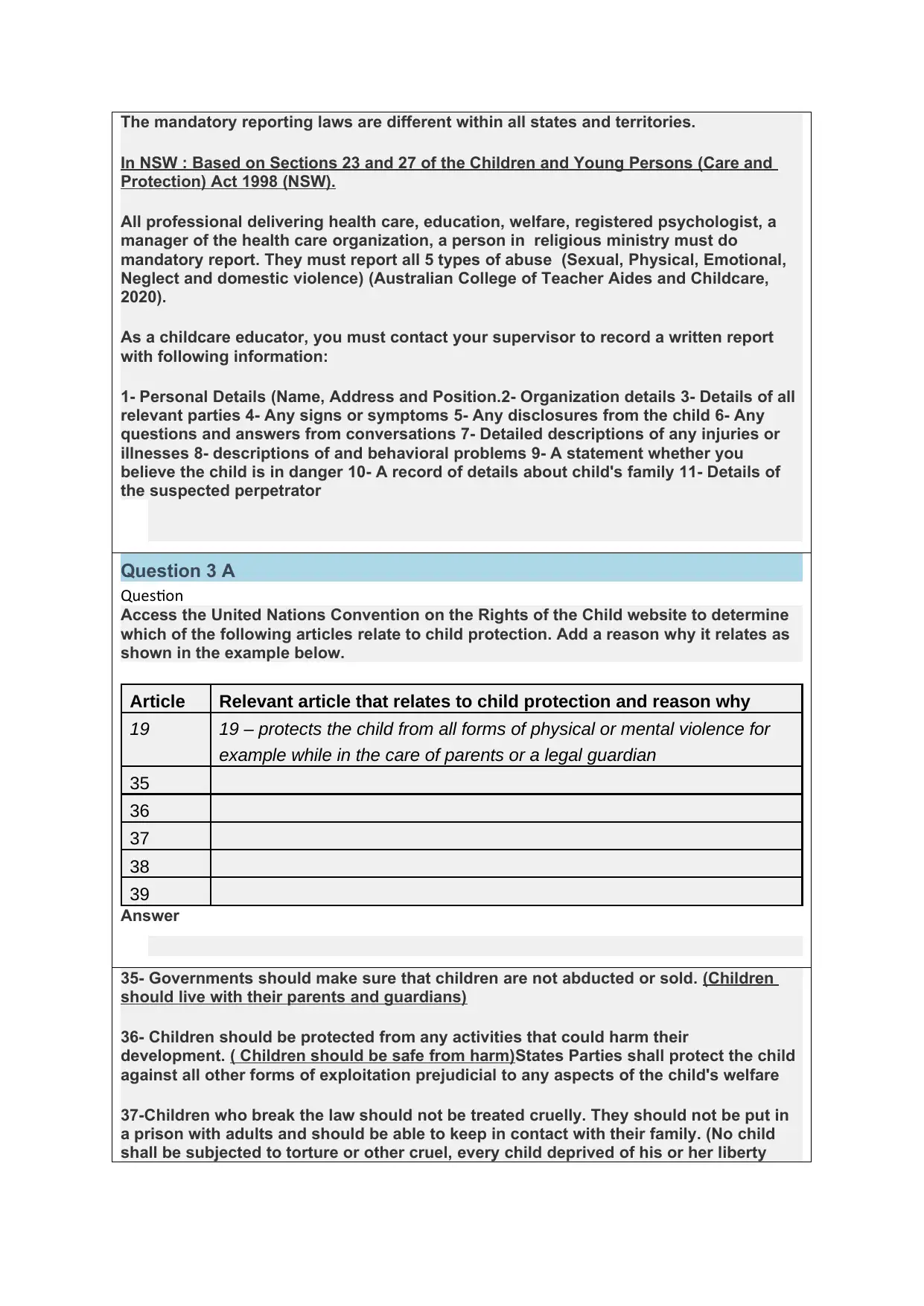
The mandatory reporting laws are different within all states and territories.
In NSW : Based on Sections 23 and 27 of the Children and Young Persons (Care and
Protection) Act 1998 (NSW).
All professional delivering health care, education, welfare, registered psychologist, a
manager of the health care organization, a person in religious ministry must do
mandatory report. They must report all 5 types of abuse (Sexual, Physical, Emotional,
Neglect and domestic violence) (Australian College of Teacher Aides and Childcare,
2020).
As a childcare educator, you must contact your supervisor to record a written report
with following information:
1- Personal Details (Name, Address and Position.2- Organization details 3- Details of all
relevant parties 4- Any signs or symptoms 5- Any disclosures from the child 6- Any
questions and answers from conversations 7- Detailed descriptions of any injuries or
illnesses 8- descriptions of and behavioral problems 9- A statement whether you
believe the child is in danger 10- A record of details about child's family 11- Details of
the suspected perpetrator
Question 3 A
Question
Access the United Nations Convention on the Rights of the Child website to determine
which of the following articles relate to child protection. Add a reason why it relates as
shown in the example below.
Article Relevant article that relates to child protection and reason why
19 19 – protects the child from all forms of physical or mental violence for
example while in the care of parents or a legal guardian
35
36
37
38
39
Answer
35- Governments should make sure that children are not abducted or sold. (Children
should live with their parents and guardians)
36- Children should be protected from any activities that could harm their
development. ( Children should be safe from harm)States Parties shall protect the child
against all other forms of exploitation prejudicial to any aspects of the child's welfare
37-Children who break the law should not be treated cruelly. They should not be put in
a prison with adults and should be able to keep in contact with their family. (No child
shall be subjected to torture or other cruel, every child deprived of his or her liberty
In NSW : Based on Sections 23 and 27 of the Children and Young Persons (Care and
Protection) Act 1998 (NSW).
All professional delivering health care, education, welfare, registered psychologist, a
manager of the health care organization, a person in religious ministry must do
mandatory report. They must report all 5 types of abuse (Sexual, Physical, Emotional,
Neglect and domestic violence) (Australian College of Teacher Aides and Childcare,
2020).
As a childcare educator, you must contact your supervisor to record a written report
with following information:
1- Personal Details (Name, Address and Position.2- Organization details 3- Details of all
relevant parties 4- Any signs or symptoms 5- Any disclosures from the child 6- Any
questions and answers from conversations 7- Detailed descriptions of any injuries or
illnesses 8- descriptions of and behavioral problems 9- A statement whether you
believe the child is in danger 10- A record of details about child's family 11- Details of
the suspected perpetrator
Question 3 A
Question
Access the United Nations Convention on the Rights of the Child website to determine
which of the following articles relate to child protection. Add a reason why it relates as
shown in the example below.
Article Relevant article that relates to child protection and reason why
19 19 – protects the child from all forms of physical or mental violence for
example while in the care of parents or a legal guardian
35
36
37
38
39
Answer
35- Governments should make sure that children are not abducted or sold. (Children
should live with their parents and guardians)
36- Children should be protected from any activities that could harm their
development. ( Children should be safe from harm)States Parties shall protect the child
against all other forms of exploitation prejudicial to any aspects of the child's welfare
37-Children who break the law should not be treated cruelly. They should not be put in
a prison with adults and should be able to keep in contact with their family. (No child
shall be subjected to torture or other cruel, every child deprived of his or her liberty
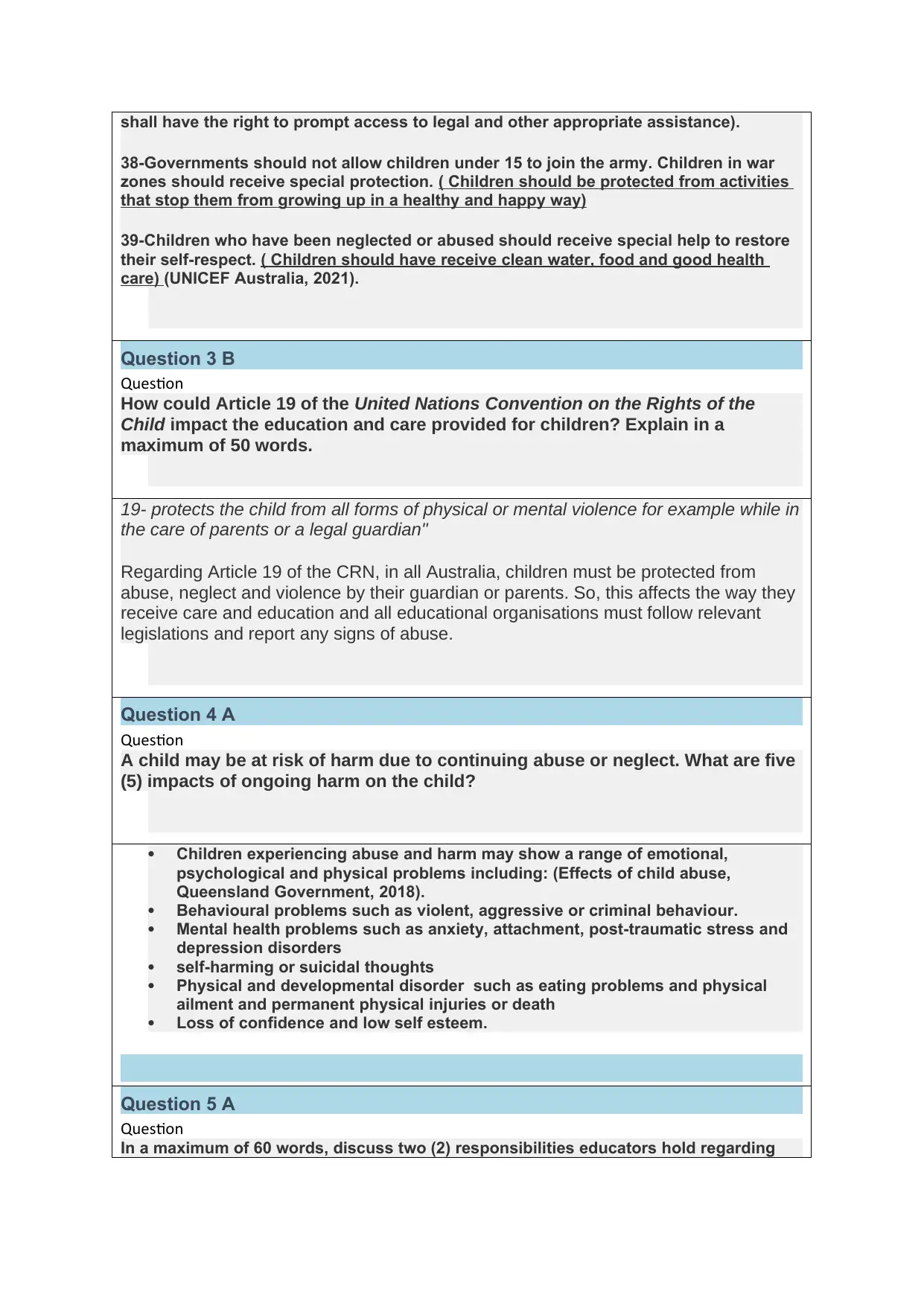
shall have the right to prompt access to legal and other appropriate assistance).
38-Governments should not allow children under 15 to join the army. Children in war
zones should receive special protection. ( Children should be protected from activities
that stop them from growing up in a healthy and happy way)
39-Children who have been neglected or abused should receive special help to restore
their self-respect. ( Children should have receive clean water, food and good health
care) (UNICEF Australia, 2021).
Question 3 B
Question
How could Article 19 of the United Nations Convention on the Rights of the
Child impact the education and care provided for children? Explain in a
maximum of 50 words.
19- protects the child from all forms of physical or mental violence for example while in
the care of parents or a legal guardian"
Regarding Article 19 of the CRN, in all Australia, children must be protected from
abuse, neglect and violence by their guardian or parents. So, this affects the way they
receive care and education and all educational organisations must follow relevant
legislations and report any signs of abuse.
Question 4 A
Question
A child may be at risk of harm due to continuing abuse or neglect. What are five
(5) impacts of ongoing harm on the child?
Children experiencing abuse and harm may show a range of emotional,
psychological and physical problems including: (Effects of child abuse,
Queensland Government, 2018).
Behavioural problems such as violent, aggressive or criminal behaviour.
Mental health problems such as anxiety, attachment, post-traumatic stress and
depression disorders
self-harming or suicidal thoughts
Physical and developmental disorder such as eating problems and physical
ailment and permanent physical injuries or death
Loss of confidence and low self esteem.
Question 5 A
Question
In a maximum of 60 words, discuss two (2) responsibilities educators hold regarding
38-Governments should not allow children under 15 to join the army. Children in war
zones should receive special protection. ( Children should be protected from activities
that stop them from growing up in a healthy and happy way)
39-Children who have been neglected or abused should receive special help to restore
their self-respect. ( Children should have receive clean water, food and good health
care) (UNICEF Australia, 2021).
Question 3 B
Question
How could Article 19 of the United Nations Convention on the Rights of the
Child impact the education and care provided for children? Explain in a
maximum of 50 words.
19- protects the child from all forms of physical or mental violence for example while in
the care of parents or a legal guardian"
Regarding Article 19 of the CRN, in all Australia, children must be protected from
abuse, neglect and violence by their guardian or parents. So, this affects the way they
receive care and education and all educational organisations must follow relevant
legislations and report any signs of abuse.
Question 4 A
Question
A child may be at risk of harm due to continuing abuse or neglect. What are five
(5) impacts of ongoing harm on the child?
Children experiencing abuse and harm may show a range of emotional,
psychological and physical problems including: (Effects of child abuse,
Queensland Government, 2018).
Behavioural problems such as violent, aggressive or criminal behaviour.
Mental health problems such as anxiety, attachment, post-traumatic stress and
depression disorders
self-harming or suicidal thoughts
Physical and developmental disorder such as eating problems and physical
ailment and permanent physical injuries or death
Loss of confidence and low self esteem.
Question 5 A
Question
In a maximum of 60 words, discuss two (2) responsibilities educators hold regarding
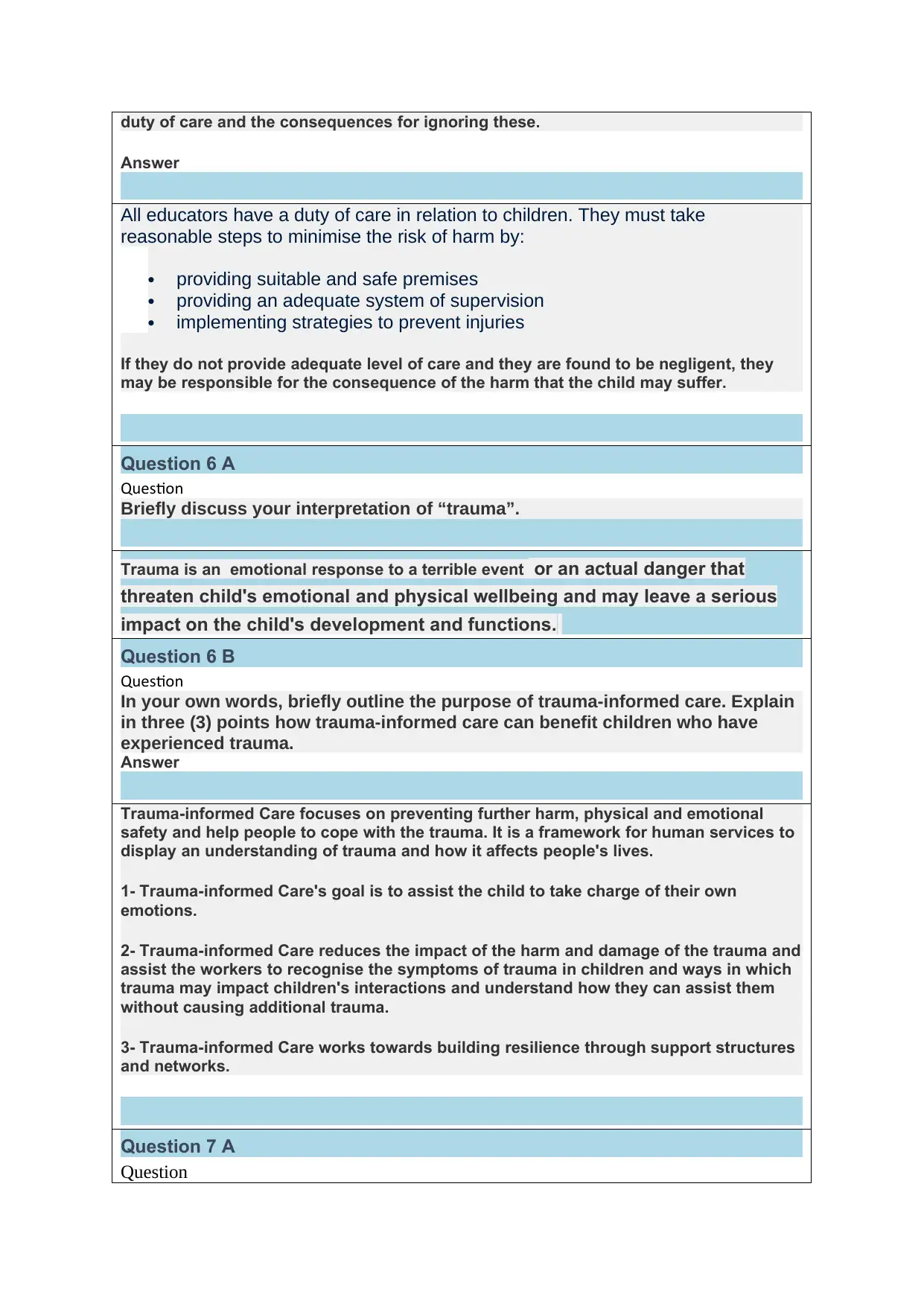
duty of care and the consequences for ignoring these.
Answer
All educators have a duty of care in relation to children. They must take
reasonable steps to minimise the risk of harm by:
providing suitable and safe premises
providing an adequate system of supervision
implementing strategies to prevent injuries
If they do not provide adequate level of care and they are found to be negligent, they
may be responsible for the consequence of the harm that the child may suffer.
Question 6 A
Question
Briefly discuss your interpretation of “trauma”.
Trauma is an emotional response to a terrible event or an actual danger that
threaten child's emotional and physical wellbeing and may leave a serious
impact on the child's development and functions.
Question 6 B
Question
In your own words, briefly outline the purpose of trauma-informed care. Explain
in three (3) points how trauma-informed care can benefit children who have
experienced trauma.
Answer
Trauma-informed Care focuses on preventing further harm, physical and emotional
safety and help people to cope with the trauma. It is a framework for human services to
display an understanding of trauma and how it affects people's lives.
1- Trauma-informed Care's goal is to assist the child to take charge of their own
emotions.
2- Trauma-informed Care reduces the impact of the harm and damage of the trauma and
assist the workers to recognise the symptoms of trauma in children and ways in which
trauma may impact children's interactions and understand how they can assist them
without causing additional trauma.
3- Trauma-informed Care works towards building resilience through support structures
and networks.
Question 7 A
Question
Answer
All educators have a duty of care in relation to children. They must take
reasonable steps to minimise the risk of harm by:
providing suitable and safe premises
providing an adequate system of supervision
implementing strategies to prevent injuries
If they do not provide adequate level of care and they are found to be negligent, they
may be responsible for the consequence of the harm that the child may suffer.
Question 6 A
Question
Briefly discuss your interpretation of “trauma”.
Trauma is an emotional response to a terrible event or an actual danger that
threaten child's emotional and physical wellbeing and may leave a serious
impact on the child's development and functions.
Question 6 B
Question
In your own words, briefly outline the purpose of trauma-informed care. Explain
in three (3) points how trauma-informed care can benefit children who have
experienced trauma.
Answer
Trauma-informed Care focuses on preventing further harm, physical and emotional
safety and help people to cope with the trauma. It is a framework for human services to
display an understanding of trauma and how it affects people's lives.
1- Trauma-informed Care's goal is to assist the child to take charge of their own
emotions.
2- Trauma-informed Care reduces the impact of the harm and damage of the trauma and
assist the workers to recognise the symptoms of trauma in children and ways in which
trauma may impact children's interactions and understand how they can assist them
without causing additional trauma.
3- Trauma-informed Care works towards building resilience through support structures
and networks.
Question 7 A
Question
Paraphrase This Document
Need a fresh take? Get an instant paraphrase of this document with our AI Paraphraser
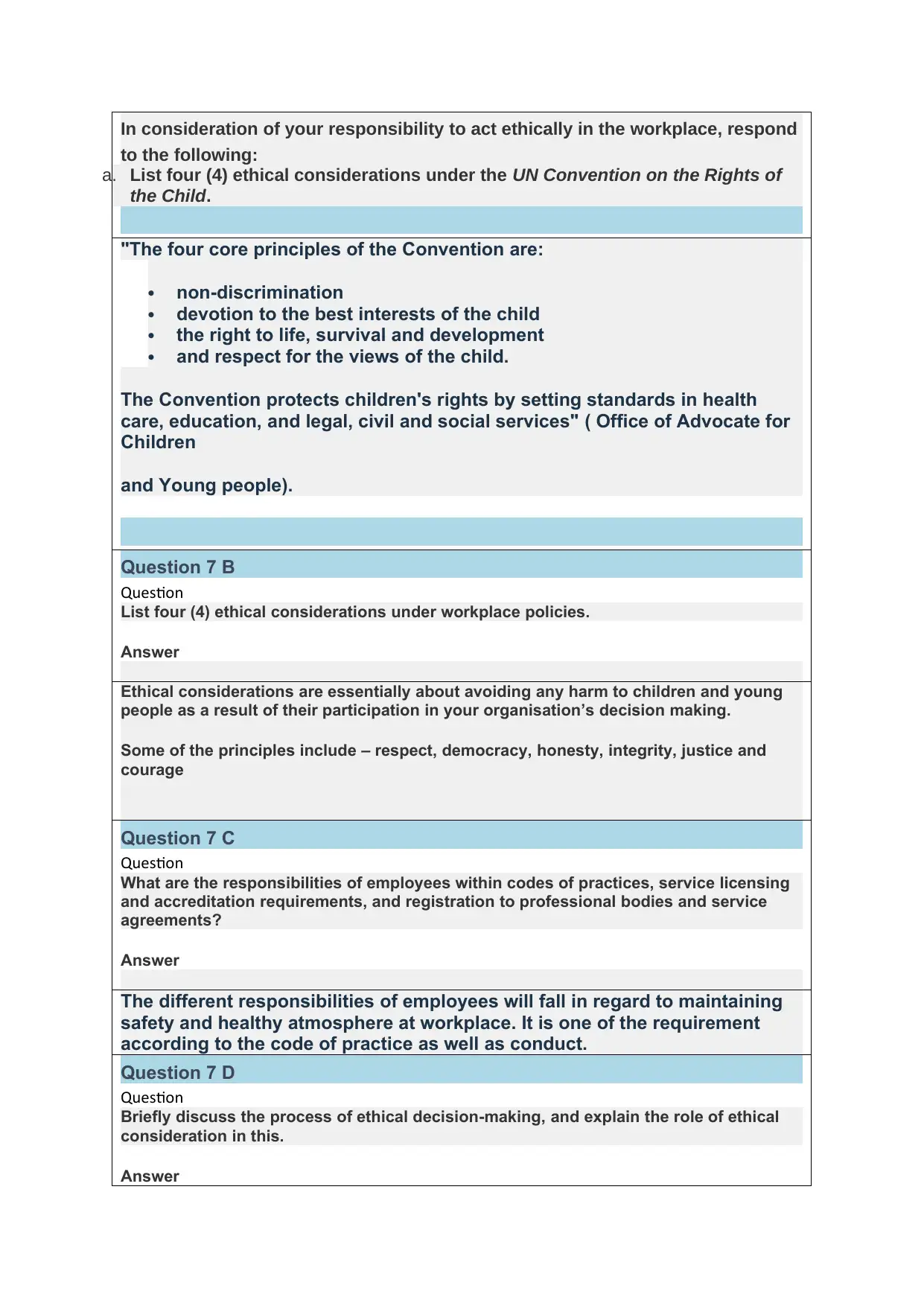
In consideration of your responsibility to act ethically in the workplace, respond
to the following:
a. List four (4) ethical considerations under the UN Convention on the Rights of
the Child.
"The four core principles of the Convention are:
non-discrimination
devotion to the best interests of the child
the right to life, survival and development
and respect for the views of the child.
The Convention protects children's rights by setting standards in health
care, education, and legal, civil and social services" ( Office of Advocate for
Children
and Young people).
Question 7 B
Question
List four (4) ethical considerations under workplace policies.
Answer
Ethical considerations are essentially about avoiding any harm to children and young
people as a result of their participation in your organisation’s decision making.
Some of the principles include – respect, democracy, honesty, integrity, justice and
courage
Question 7 C
Question
What are the responsibilities of employees within codes of practices, service licensing
and accreditation requirements, and registration to professional bodies and service
agreements?
Answer
The different responsibilities of employees will fall in regard to maintaining
safety and healthy atmosphere at workplace. It is one of the requirement
according to the code of practice as well as conduct.
Question 7 D
Question
Briefly discuss the process of ethical decision-making, and explain the role of ethical
consideration in this.
Answer
to the following:
a. List four (4) ethical considerations under the UN Convention on the Rights of
the Child.
"The four core principles of the Convention are:
non-discrimination
devotion to the best interests of the child
the right to life, survival and development
and respect for the views of the child.
The Convention protects children's rights by setting standards in health
care, education, and legal, civil and social services" ( Office of Advocate for
Children
and Young people).
Question 7 B
Question
List four (4) ethical considerations under workplace policies.
Answer
Ethical considerations are essentially about avoiding any harm to children and young
people as a result of their participation in your organisation’s decision making.
Some of the principles include – respect, democracy, honesty, integrity, justice and
courage
Question 7 C
Question
What are the responsibilities of employees within codes of practices, service licensing
and accreditation requirements, and registration to professional bodies and service
agreements?
Answer
The different responsibilities of employees will fall in regard to maintaining
safety and healthy atmosphere at workplace. It is one of the requirement
according to the code of practice as well as conduct.
Question 7 D
Question
Briefly discuss the process of ethical decision-making, and explain the role of ethical
consideration in this.
Answer
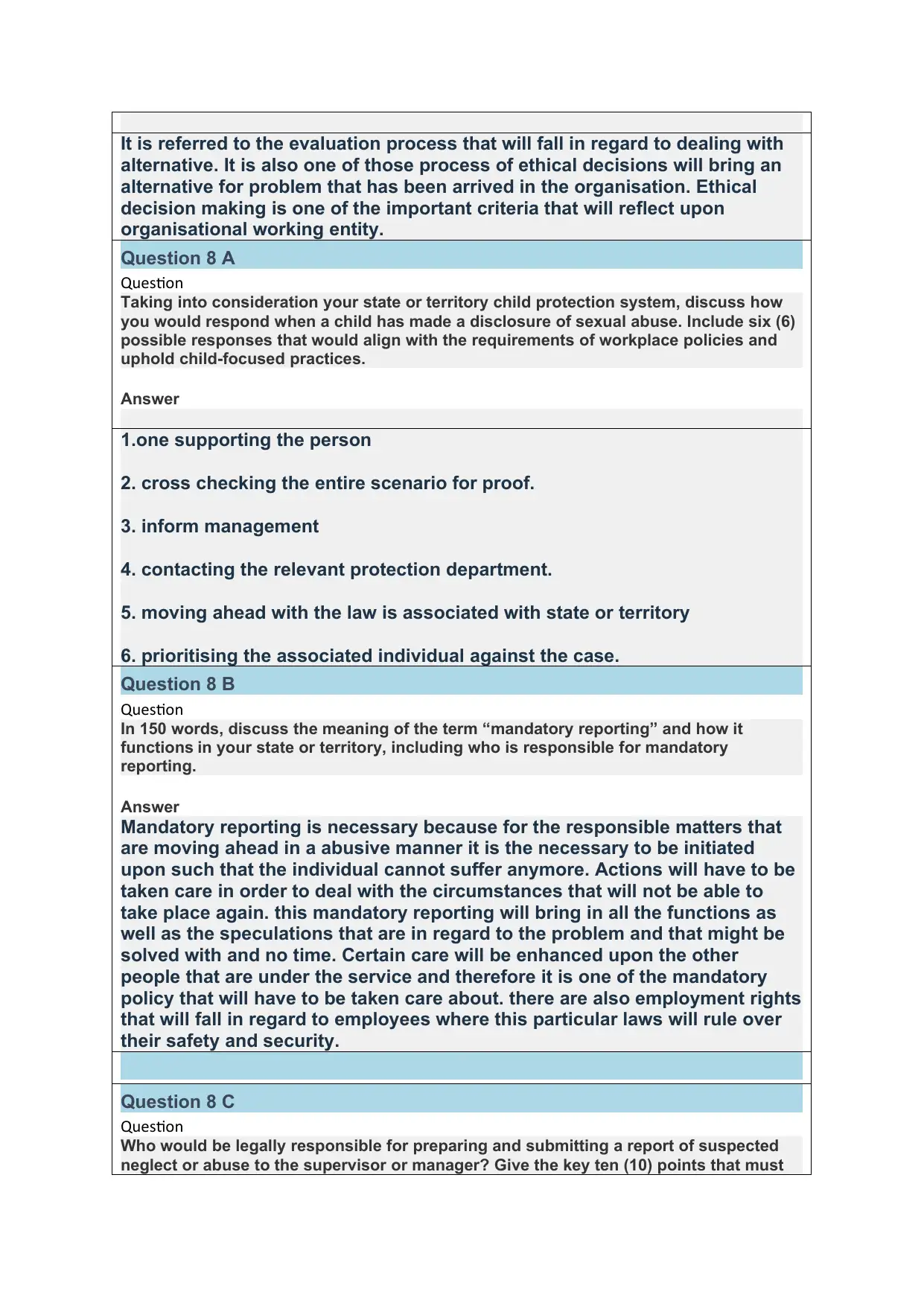
It is referred to the evaluation process that will fall in regard to dealing with
alternative. It is also one of those process of ethical decisions will bring an
alternative for problem that has been arrived in the organisation. Ethical
decision making is one of the important criteria that will reflect upon
organisational working entity.
Question 8 A
Question
Taking into consideration your state or territory child protection system, discuss how
you would respond when a child has made a disclosure of sexual abuse. Include six (6)
possible responses that would align with the requirements of workplace policies and
uphold child-focused practices.
Answer
1.one supporting the person
2. cross checking the entire scenario for proof.
3. inform management
4. contacting the relevant protection department.
5. moving ahead with the law is associated with state or territory
6. prioritising the associated individual against the case.
Question 8 B
Question
In 150 words, discuss the meaning of the term “mandatory reporting” and how it
functions in your state or territory, including who is responsible for mandatory
reporting.
Answer
Mandatory reporting is necessary because for the responsible matters that
are moving ahead in a abusive manner it is the necessary to be initiated
upon such that the individual cannot suffer anymore. Actions will have to be
taken care in order to deal with the circumstances that will not be able to
take place again. this mandatory reporting will bring in all the functions as
well as the speculations that are in regard to the problem and that might be
solved with and no time. Certain care will be enhanced upon the other
people that are under the service and therefore it is one of the mandatory
policy that will have to be taken care about. there are also employment rights
that will fall in regard to employees where this particular laws will rule over
their safety and security.
Question 8 C
Question
Who would be legally responsible for preparing and submitting a report of suspected
neglect or abuse to the supervisor or manager? Give the key ten (10) points that must
alternative. It is also one of those process of ethical decisions will bring an
alternative for problem that has been arrived in the organisation. Ethical
decision making is one of the important criteria that will reflect upon
organisational working entity.
Question 8 A
Question
Taking into consideration your state or territory child protection system, discuss how
you would respond when a child has made a disclosure of sexual abuse. Include six (6)
possible responses that would align with the requirements of workplace policies and
uphold child-focused practices.
Answer
1.one supporting the person
2. cross checking the entire scenario for proof.
3. inform management
4. contacting the relevant protection department.
5. moving ahead with the law is associated with state or territory
6. prioritising the associated individual against the case.
Question 8 B
Question
In 150 words, discuss the meaning of the term “mandatory reporting” and how it
functions in your state or territory, including who is responsible for mandatory
reporting.
Answer
Mandatory reporting is necessary because for the responsible matters that
are moving ahead in a abusive manner it is the necessary to be initiated
upon such that the individual cannot suffer anymore. Actions will have to be
taken care in order to deal with the circumstances that will not be able to
take place again. this mandatory reporting will bring in all the functions as
well as the speculations that are in regard to the problem and that might be
solved with and no time. Certain care will be enhanced upon the other
people that are under the service and therefore it is one of the mandatory
policy that will have to be taken care about. there are also employment rights
that will fall in regard to employees where this particular laws will rule over
their safety and security.
Question 8 C
Question
Who would be legally responsible for preparing and submitting a report of suspected
neglect or abuse to the supervisor or manager? Give the key ten (10) points that must
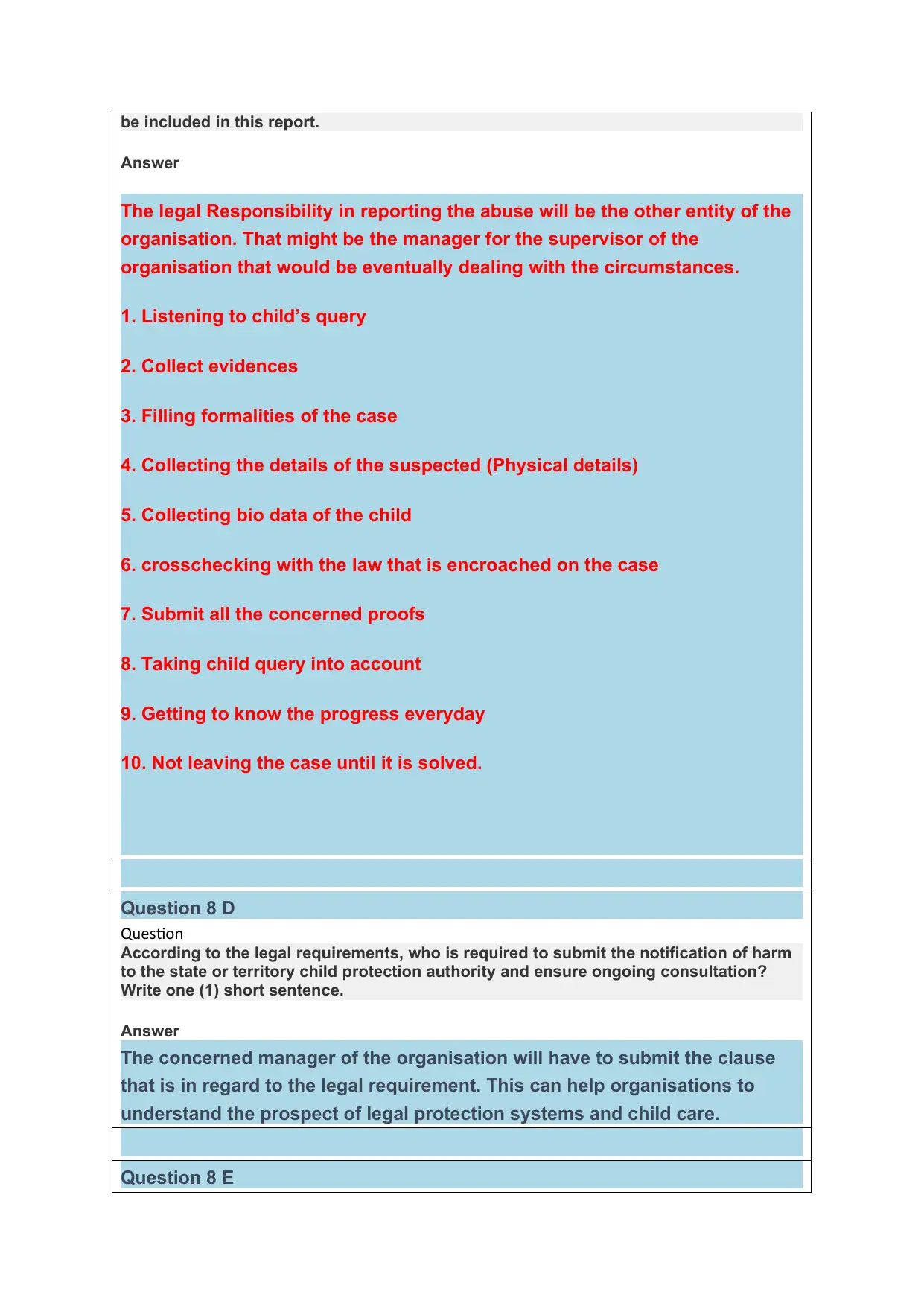
be included in this report.
Answer
The legal Responsibility in reporting the abuse will be the other entity of the
organisation. That might be the manager for the supervisor of the
organisation that would be eventually dealing with the circumstances.
1. Listening to child’s query
2. Collect evidences
3. Filling formalities of the case
4. Collecting the details of the suspected (Physical details)
5. Collecting bio data of the child
6. crosschecking with the law that is encroached on the case
7. Submit all the concerned proofs
8. Taking child query into account
9. Getting to know the progress everyday
10. Not leaving the case until it is solved.
Question 8 D
Question
According to the legal requirements, who is required to submit the notification of harm
to the state or territory child protection authority and ensure ongoing consultation?
Write one (1) short sentence.
Answer
The concerned manager of the organisation will have to submit the clause
that is in regard to the legal requirement. This can help organisations to
understand the prospect of legal protection systems and child care.
Question 8 E
Answer
The legal Responsibility in reporting the abuse will be the other entity of the
organisation. That might be the manager for the supervisor of the
organisation that would be eventually dealing with the circumstances.
1. Listening to child’s query
2. Collect evidences
3. Filling formalities of the case
4. Collecting the details of the suspected (Physical details)
5. Collecting bio data of the child
6. crosschecking with the law that is encroached on the case
7. Submit all the concerned proofs
8. Taking child query into account
9. Getting to know the progress everyday
10. Not leaving the case until it is solved.
Question 8 D
Question
According to the legal requirements, who is required to submit the notification of harm
to the state or territory child protection authority and ensure ongoing consultation?
Write one (1) short sentence.
Answer
The concerned manager of the organisation will have to submit the clause
that is in regard to the legal requirement. This can help organisations to
understand the prospect of legal protection systems and child care.
Question 8 E
Secure Best Marks with AI Grader
Need help grading? Try our AI Grader for instant feedback on your assignments.

Question
If there were a conflict between the state/territory statutory and policy requirements and
the policies of your organisation, which policies would need to be followed in this
instance and why?
Highlight which policies:
State or territory statutory and policy requirements OR
School/ service policies
Why these policies: One (1) short sentence.
The state or territory statutory policy is included in this regard. This is
because the conflict that is in between them will have to be solved by
identifying the conflicts that are not able. This is because the particular state
or territory statutory and policy requirements teacher will deal with the
conflicts that are a part of organisational entity and also bring about a
conclusion.
Question 9 A
Question
List two (2) statutory policies that relate to your job role?
Answer
The two statutory policies that are falling in regard to the job analysis
include the work health and safety act 2012, compassion in care code of
practice, safeguarding children young people and vulnerable adults from
harm, neglect and abuse.
Question 9 B
Question
How are organisational standards, policies, and procedures influenced by child
protection legislation, and what are the most important procedures relating to an
educator? Explain in a maximum of 50 words.
Answer
In order to ensure the fact that quality framework is being carry forwarded
that these particular formulations will fall in regard to the organisational
procedures. that can also stand as an information source that will bring forth
the procedure that are recognised as one of the acknowledgement in regard
to employees. They are necessary in order to deal where the quality issues
of the organisational operation and also the protection towards
discrimination of employees.
If there were a conflict between the state/territory statutory and policy requirements and
the policies of your organisation, which policies would need to be followed in this
instance and why?
Highlight which policies:
State or territory statutory and policy requirements OR
School/ service policies
Why these policies: One (1) short sentence.
The state or territory statutory policy is included in this regard. This is
because the conflict that is in between them will have to be solved by
identifying the conflicts that are not able. This is because the particular state
or territory statutory and policy requirements teacher will deal with the
conflicts that are a part of organisational entity and also bring about a
conclusion.
Question 9 A
Question
List two (2) statutory policies that relate to your job role?
Answer
The two statutory policies that are falling in regard to the job analysis
include the work health and safety act 2012, compassion in care code of
practice, safeguarding children young people and vulnerable adults from
harm, neglect and abuse.
Question 9 B
Question
How are organisational standards, policies, and procedures influenced by child
protection legislation, and what are the most important procedures relating to an
educator? Explain in a maximum of 50 words.
Answer
In order to ensure the fact that quality framework is being carry forwarded
that these particular formulations will fall in regard to the organisational
procedures. that can also stand as an information source that will bring forth
the procedure that are recognised as one of the acknowledgement in regard
to employees. They are necessary in order to deal where the quality issues
of the organisational operation and also the protection towards
discrimination of employees.

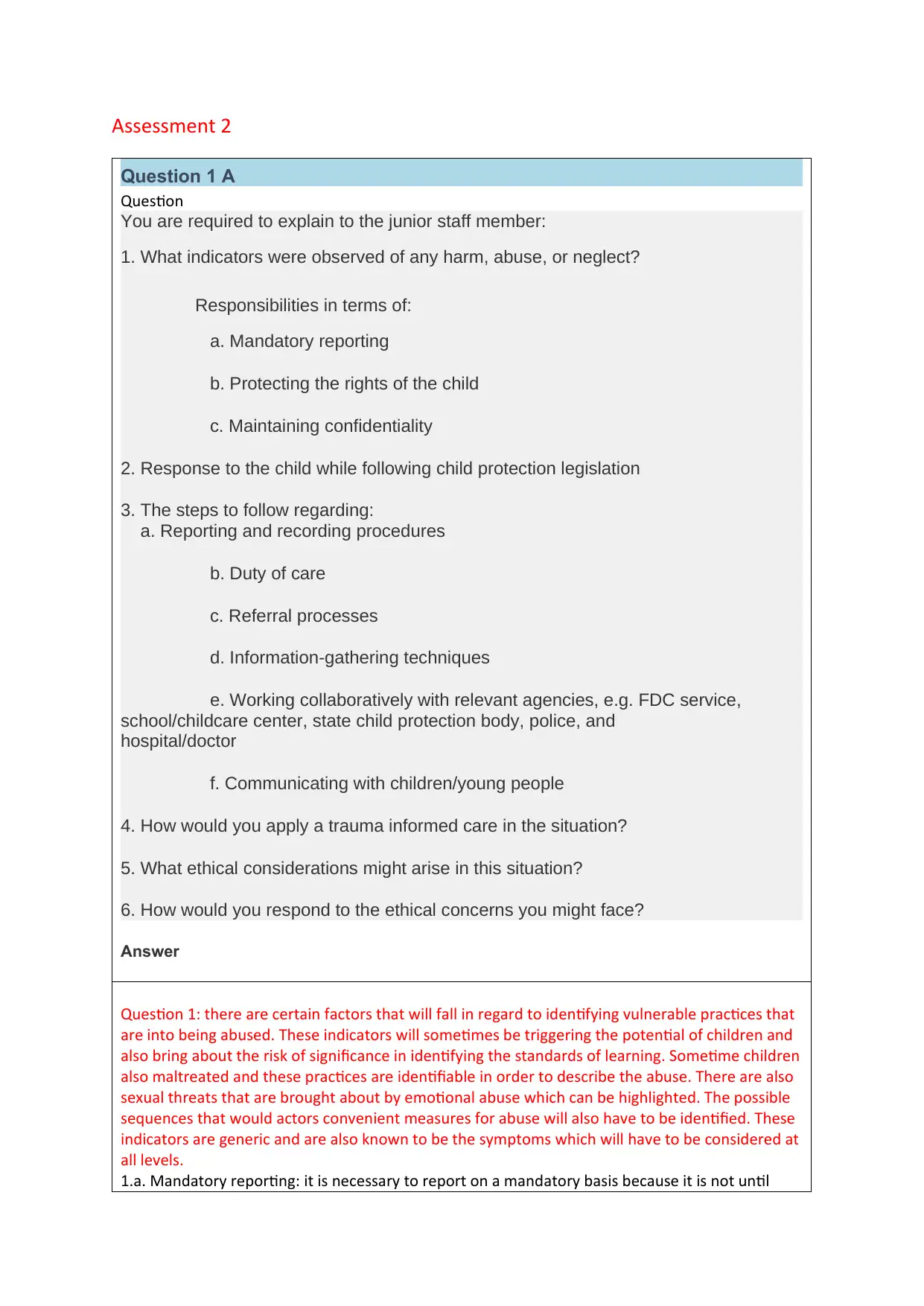
Assessment 2
Question 1 A
Question
You are required to explain to the junior staff member:
1. What indicators were observed of any harm, abuse, or neglect?
Responsibilities in terms of:
a. Mandatory reporting
b. Protecting the rights of the child
c. Maintaining confidentiality
2. Response to the child while following child protection legislation
3. The steps to follow regarding:
a. Reporting and recording procedures
b. Duty of care
c. Referral processes
d. Information-gathering techniques
e. Working collaboratively with relevant agencies, e.g. FDC service,
school/childcare center, state child protection body, police, and
hospital/doctor
f. Communicating with children/young people
4. How would you apply a trauma informed care in the situation?
5. What ethical considerations might arise in this situation?
6. How would you respond to the ethical concerns you might face?
Answer
Question 1: there are certain factors that will fall in regard to identifying vulnerable practices that
are into being abused. These indicators will sometimes be triggering the potential of children and
also bring about the risk of significance in identifying the standards of learning. Sometime children
also maltreated and these practices are identifiable in order to describe the abuse. There are also
sexual threats that are brought about by emotional abuse which can be highlighted. The possible
sequences that would actors convenient measures for abuse will also have to be identified. These
indicators are generic and are also known to be the symptoms which will have to be considered at
all levels.
1.a. Mandatory reporting: it is necessary to report on a mandatory basis because it is not until
Question 1 A
Question
You are required to explain to the junior staff member:
1. What indicators were observed of any harm, abuse, or neglect?
Responsibilities in terms of:
a. Mandatory reporting
b. Protecting the rights of the child
c. Maintaining confidentiality
2. Response to the child while following child protection legislation
3. The steps to follow regarding:
a. Reporting and recording procedures
b. Duty of care
c. Referral processes
d. Information-gathering techniques
e. Working collaboratively with relevant agencies, e.g. FDC service,
school/childcare center, state child protection body, police, and
hospital/doctor
f. Communicating with children/young people
4. How would you apply a trauma informed care in the situation?
5. What ethical considerations might arise in this situation?
6. How would you respond to the ethical concerns you might face?
Answer
Question 1: there are certain factors that will fall in regard to identifying vulnerable practices that
are into being abused. These indicators will sometimes be triggering the potential of children and
also bring about the risk of significance in identifying the standards of learning. Sometime children
also maltreated and these practices are identifiable in order to describe the abuse. There are also
sexual threats that are brought about by emotional abuse which can be highlighted. The possible
sequences that would actors convenient measures for abuse will also have to be identified. These
indicators are generic and are also known to be the symptoms which will have to be considered at
all levels.
1.a. Mandatory reporting: it is necessary to report on a mandatory basis because it is not until
Paraphrase This Document
Need a fresh take? Get an instant paraphrase of this document with our AI Paraphraser

when the issue is reported that it gets to be performed and also not be able to repeat at the same
time. This mandatory reporting will also help officials to take charge over the case within no time.
B. Protecting the rights of child: by informing the concerned authorities regarding the things that
are happening with respect to their obligation or the abuse the rights that are oriented with the
children can therefore be enacted. This will help people to identify their standards and can also
help them not to misuse their ability to deal with the abuse later on..
C. Confidentiality is one of the important criteria where this will have to be maintained at all
levels. By maintaining confidentiality the child will prosper on a good term and also the case can
be even more prosperous.
.
2. By dealing with child protection legislation the response to child will obviously be the ones that
will stay firm with respect to threatening. Threatening will be one of the criteria that will be carry
forwarded with respect to the child during the abuse and that will have to be protected. This
response will have to be true to knowledge such that the right amount of action can only be taken
based on the proof that the child is depicting.
3.a. Duty of care: the amount of care will have to be fostered such that the individual who is
under abuse will not feel sensation of guilt. It is necessary to take charge over the case which is
one of the careful tactic that people can usually do.
B. Reporting and recording procedures: the process that are involved in dealing with the recording
of abuse will have to be taken care about because this is one of the prominent aspect that will
have to be dealt. Without a proper reporting and recording structures this cannot be taken care
about therefore the action will have to be first recorded respectively with the right procedure of
intimating authorities regarding the things that have happened.
C. Peripheral processes: the different processes can initiate the kind of care that can be essential
for dealing the case. The abuse will obviously be a threatening one and therefore the reference
can play a major role in bringing about justice towards the fact that a person is being abused.
D. Information gathering techniques: the techniques that are involved in gathering information is
also one of the criteria. This might be something that will revolve around a cctv footage where it
can bring about the probable evidences that are in regard to the culprit. This can also be one of
the issue where the proof will not be able to stand but the live recording can be helpful.
E. Working collaboratively with relevant agencies: the collaboration of working with relevant
agencies can be helpful in bringing about the protection that is in regard to the abuse. They can
stand as a unique entity and their formulations can reflect over the choices that are to be made
on a collaborative work atmosphere enough.
F. Communicating with children and young people: it is necessary to communicate with children
and young people in order to draw evidences of the issue that has happened. This can be one of
the proof that is generated over protecting the rights of a person who is abused.
4. The trauma-informed care is nothing but the kind of state that a person usually deal with upon
not being able to adhere the level of tolerance that is being depicted over a certain circumstances.
When the person is not being able to consciously deal with the abuse that has happened and
bring about things that are not appropriate. The state of mind will also be guilty and that will
result in an extravagant situations.
5. The considerations in this regard will be those that will revolve around the truth that is in
regard to the situation. The process will have to be carry forwarded without showing partiality
towards people who are there on. The loss and also the regulations will have to be such that they
will have to be stern in deriving the standards of the case
6. I would probably respond according to the situations that are happening. The ethical concerns if
not practiced i would be able to raise my voice against the things that can be corrected. If the
ethical considerations are followed i would probably man is things accordingly by abiding by the
rules.
time. This mandatory reporting will also help officials to take charge over the case within no time.
B. Protecting the rights of child: by informing the concerned authorities regarding the things that
are happening with respect to their obligation or the abuse the rights that are oriented with the
children can therefore be enacted. This will help people to identify their standards and can also
help them not to misuse their ability to deal with the abuse later on..
C. Confidentiality is one of the important criteria where this will have to be maintained at all
levels. By maintaining confidentiality the child will prosper on a good term and also the case can
be even more prosperous.
.
2. By dealing with child protection legislation the response to child will obviously be the ones that
will stay firm with respect to threatening. Threatening will be one of the criteria that will be carry
forwarded with respect to the child during the abuse and that will have to be protected. This
response will have to be true to knowledge such that the right amount of action can only be taken
based on the proof that the child is depicting.
3.a. Duty of care: the amount of care will have to be fostered such that the individual who is
under abuse will not feel sensation of guilt. It is necessary to take charge over the case which is
one of the careful tactic that people can usually do.
B. Reporting and recording procedures: the process that are involved in dealing with the recording
of abuse will have to be taken care about because this is one of the prominent aspect that will
have to be dealt. Without a proper reporting and recording structures this cannot be taken care
about therefore the action will have to be first recorded respectively with the right procedure of
intimating authorities regarding the things that have happened.
C. Peripheral processes: the different processes can initiate the kind of care that can be essential
for dealing the case. The abuse will obviously be a threatening one and therefore the reference
can play a major role in bringing about justice towards the fact that a person is being abused.
D. Information gathering techniques: the techniques that are involved in gathering information is
also one of the criteria. This might be something that will revolve around a cctv footage where it
can bring about the probable evidences that are in regard to the culprit. This can also be one of
the issue where the proof will not be able to stand but the live recording can be helpful.
E. Working collaboratively with relevant agencies: the collaboration of working with relevant
agencies can be helpful in bringing about the protection that is in regard to the abuse. They can
stand as a unique entity and their formulations can reflect over the choices that are to be made
on a collaborative work atmosphere enough.
F. Communicating with children and young people: it is necessary to communicate with children
and young people in order to draw evidences of the issue that has happened. This can be one of
the proof that is generated over protecting the rights of a person who is abused.
4. The trauma-informed care is nothing but the kind of state that a person usually deal with upon
not being able to adhere the level of tolerance that is being depicted over a certain circumstances.
When the person is not being able to consciously deal with the abuse that has happened and
bring about things that are not appropriate. The state of mind will also be guilty and that will
result in an extravagant situations.
5. The considerations in this regard will be those that will revolve around the truth that is in
regard to the situation. The process will have to be carry forwarded without showing partiality
towards people who are there on. The loss and also the regulations will have to be such that they
will have to be stern in deriving the standards of the case
6. I would probably respond according to the situations that are happening. The ethical concerns if
not practiced i would be able to raise my voice against the things that can be corrected. If the
ethical considerations are followed i would probably man is things accordingly by abiding by the
rules.

1 out of 15
Your All-in-One AI-Powered Toolkit for Academic Success.
+13062052269
info@desklib.com
Available 24*7 on WhatsApp / Email
![[object Object]](/_next/static/media/star-bottom.7253800d.svg)
Unlock your academic potential
© 2024 | Zucol Services PVT LTD | All rights reserved.





